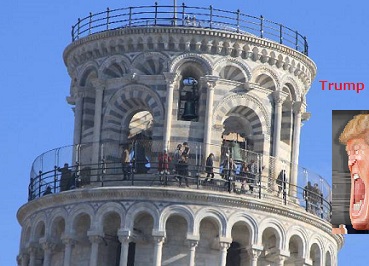
彼(ガリレオ)はこの原理(慣性の法則)を落下する物体に関する実験結果を説明するのに適用した。アリストテレスは,物体が落下する速度はその重さ(重量)に比例すると教えていた。即ち,(アリストテレスの教えに従うと)10ポンドの重さの物体と1ポンドの重さの物体を同時に同じ高さから落とすと,1ポンドの重さの物体は地面に達するまでに10ポンドの重さの物体の10倍の時間がかかるはずである。ガリレオは(イタリアの)ピサで教授をしていたが(教鞭をとっていたが),他の教授たちの気持ちなどに対しまったく敬意を抱かず,アリストテレス主義者の同僚教授(たち)が講義に行く丁度その途上にある時に,彼は(ピサの)斜塔から重りをいつも落していた。大小の鉛の塊(lumps of lead)は,ほとんど同時に地面に到達していた。そのことは,ガリレオにアリストテレスが間違っていることを明らかにしたが,他の教授たちにはガリレオは邪悪であることを明らかにした(のである)。これは一つの典型的な例だが,そのような多くの悪意のある行為によって,彼は,真理は実験よりも書物に求めらるべきであると信じている人々の死滅することのない(絶えることのない)憎悪を引き起こした。 ガリレオは,空気抵抗がなく(apart from),物体が自由に落下する場合には,それらの物体は一定(不変)の加速度で落下し,加速度は,真空においては物体の容積や素材(the material of whiich composed)がどうであろうと全ての物体に対して同じである,ということを発見した。物体が真空中を自由落下する時,1秒毎に,その(落下)速度は(毎秒)約32フィートの割合で増加する。ガリレオは,また,物体が弾丸のように水平に投げられた場合,その物体は放物線(parabola)を描いて動くことも証明した。一方,以前は,物体は一定の間水平に動き,その後,垂直に落下すると考えられていた。これらの結果は,今日ではそんなにセンセーショナルな(扇情的な)こととは思われないかも知れないが,(それらの結果は)物体がどのように動くかについての厳密な数学的知識の始まりであった。彼の時代以前(にも),純粋数学は存在しており,それは演繹的であり,観察に依存しないものであったし、また,特に錬金術(alchemy)と結びついて,全く経験的な実験も存在していた。しかし,数学的法則に達するという見地から,実験の慣行を最大限始めたのは彼であり、それによって(数学的法則によって)アプリオリな(先験的な)知識が存在しないものに数学を適用することを可能にした。彼は,験証する試みを最低限行うだけでその誤りを明らかにしたであろうにもかかわらず,如何に容易に、一つの主張がある時代から次の時代へと(誤りに気づかずに)繰り返されるかということを、劇的かつ否定できないように,示すのに最大限のことを行った。アリストテレスからガリレオまでの二千年間,落下する物体の法則がアリストテレスが言った通りであるかどうかについて解答を出そうとする者は誰もいなかった(注:find out 解答を出す;考え出す)。そのような陳述(命題)を験証することは,現代の我々には当然のことに思われるかも知れないが,ガリレオの時代には天才を必要とした(のである)。
Chapter 2: The Copernican Revolution, n.10
He applied this principle in explaining the results of his experiments on falling bodies. Aristotle had taught that the speed with which a body falls is proportional to its weight ; that is to say, if a body weighing (say) ten pounds and another weighing (say) one pound were dropped from the same height at the same moment, the one weighing one pound should take ten times as long to reach the ground as the one weighing ten pounds. Galileo, who was a professor at Pisa but had no respect for the feelings of other professors, used to drop weights from the Leaning Tower just as his Aristotelian colleagues were on the way to their lectures. Big and small lumps of lead would reach the ground almost simultaneously, which proved to Galileo that Afistotle was wrong, but to the other professors that Galileo was wicked. By a number of malicious actions of which this one was typical, he incurred the undying hatred of those who believed that truth was to be sought in books rather than in experiments. Galileo discovered that, apart from the resistance of the air, when bodies fall freely they fall with a uniform acceleration, which, in a vacuum, is the same for all, no matter what their bulk or the material of which they are composed. In every second during which a body is falling freely in a vacuum, its speed increases by about 32 feet per second. He also proved that when a body is thrown horizontally, like a bullet, it moves in a parabola, whereas it had previously been supposed to move horizontally for a while, and then to fall vertically. These results may not now seem very sensational, but they were the beginning of exact mathematical knowledge as to how bodies move. Before his time, there was pure mathematics, which was deductive and did not depend upon observation, and there was a certain amount of wholly empirical experimenting, especially in connection with alchemy. But it was he who did most to inaugurate the practice of experiment with a view to arriving at a mathematical law, thereby enabling mathematics to be applied to material as to which there was no a priori knowledge. And he did most to show, dramatically and undeniably, how easy it is for an assertion to be repeated by one generation after another in spite of the fact that the slightest attempt to test it would have shown its falsehood. Throughout the 2,000 years from Aristotle to Galileo, no one had thought of finding out whether the laws of falling bodies are what Aristotle says they are. To test such statements may seem natural to us, but in Galileo’s day it required genius.
出典:Religion and Science, 1935, chapt. 2.
情報源:https://russell-j.com/beginner/RS1935_02-100.HTM
